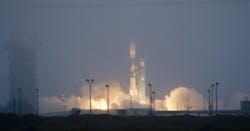NASA, CONAE, Pratt & Whitney, United Launch Alliance, others team on Age of Aquarius launch
Posted by Courtney E. HowardWASHINGTON, 13 June 2011. NASA's Age of Aquarius mission dawned with the launch of an international satellite carrying an agency-built Aquarius instrument to measure the salinity (concentration of salt) of the Earth's oceans. The data is expected to advance scientists’ understanding of the influence of salinity on: deep ocean circulation, the path of freshwater around the planet, and the Earth's climate. The observatory carries another six instruments designed to monitor natural hazards and collect a range of environmental data.The Aquarius/SAC-D (Satelite de Aplicaciones Cientificas) observatory rocketed into space from Vandenberg Air Force Base in California atop a United Launch Alliance Delta II rocket at 7:20:13 a.m. PDT. After nearly an hour, the observatory separated from the rocket's second stage and began activation procedures, such as establishing communications with ground controllers and unfurling its solar arrays. Pratt & Whitney Rocketdyne, a United Technologies Corp. company, boost the international spacecraft on a United Launch Alliance Delta II rocket with a Pratt & Whitney Rocketdyne RS-27A engine. "Aquarius is a critical component of our Earth sciences work, and part of the next generation of space-based instruments that will take our knowledge of our home planet to new heights," says NASA Deputy Administrator Lori Garver. "The innovative scientists and engineers who contributed to this mission are part of the talented team that will help America win the future and make a positive impact across the globe.""Data from this mission will advance our understanding of the ocean and prediction of the global water cycle," said Michael Freilich, director of NASA's Earth Science Division in the Science Mission Directorate at agency headquarters in Washington. "This mission demonstrates the power of international collaboration and accurate spaceborne measurements for science and societal benefit. This would not be possible without the sustained cooperation of NASA, CONAE and our other partners."Aquarius will measure salinity by sensing thermal microwave emissions from the water's surface with three radiometers. A microwave radar scatterometer will measure ocean waves that affect the precision of the salinity measurement. Aquarius was built by NASA's Jet Propulsion Laboratory in Pasadena, Calif., and the Goddard Space Flight Center in Greenbelt, Md. NASA's Launch Services Program, at Kennedy Space Center in Florida, managed the launch. CONAE is providing the SAC-D spacecraft, optical camera, thermal camera with Canada, microwave radiometer, sensors from Argentine institutions and the mission operations center. The Aquarius/SAC-D mission is a collaborative effort between NASA and Argentina's space agency, Comision Nacional de Actividades Espaciales (CONAE), with participation from Brazil, Canada, France, and Italy.
